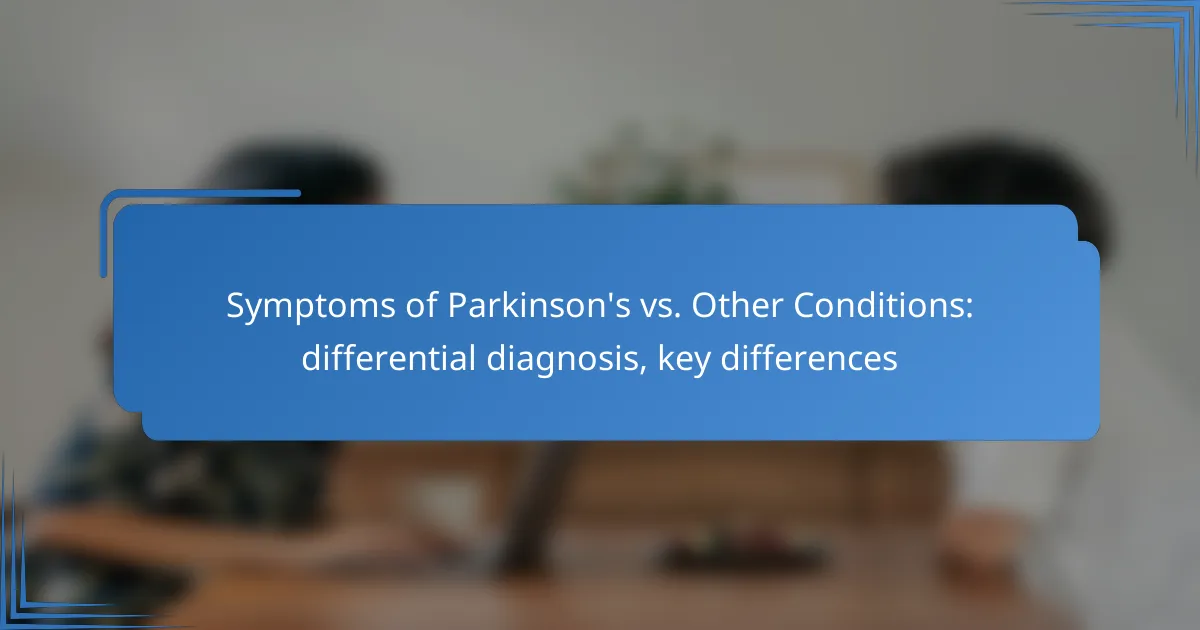Understanding the symptoms of Parkinson’s disease is vital for accurate differential diagnosis, as its motor and non-motor manifestations can overlap with other conditions. Key differences between Parkinson’s and similar disorders, such as essential tremor and Multiple Sclerosis, play a crucial role in guiding effective treatment and management strategies.

What are the key symptoms of Parkinson’s disease?
Parkinson’s disease primarily manifests through a combination of motor and non-motor symptoms. Recognizing these key symptoms is essential for differentiating Parkinson’s from other conditions.
Tremors
Tremors are often one of the most recognizable symptoms of Parkinson’s disease. They typically start in one hand and may occur when the affected limb is at rest, known as resting tremors. These tremors can diminish during movement and may not be present during sleep.
While tremors can be associated with other conditions, such as essential tremor or anxiety disorders, the characteristic resting nature of Parkinson’s tremors is a key differentiator.
Bradykinesia
Bradykinesia refers to the slowness of movement, which is a hallmark symptom of Parkinson’s disease. Individuals may notice a gradual reduction in spontaneous movements, making daily tasks more challenging. This symptom can lead to a shuffling gait and difficulty initiating movement.
Bradykinesia can be confused with other conditions, such as depression or certain neurological disorders, but the progressive nature and impact on daily life are significant indicators of Parkinson’s.
Muscle rigidity
Muscle rigidity involves stiffness and resistance to movement in the muscles, which can affect any part of the body. This symptom can lead to discomfort and a decreased range of motion. Rigidity is often assessed through a physical examination, where the clinician may feel for resistance during passive movement of the limbs.
Unlike muscle stiffness from other causes, such as arthritis, rigidity in Parkinson’s is often accompanied by a specific pattern of muscle tension that can be differentiated through clinical evaluation.
Postural instability
Postural instability refers to balance problems and difficulty maintaining an upright posture, which can increase the risk of falls. This symptom typically develops later in the disease progression and can significantly affect mobility and independence.
While other conditions may also cause balance issues, the combination of postural instability with other Parkinson’s symptoms helps in making an accurate diagnosis.
Changes in speech
Changes in speech, known as dysarthria, can manifest as a softer voice, slurred speech, or a monotone quality. These changes occur due to the muscle control issues associated with Parkinson’s disease. Individuals may find it challenging to articulate words clearly, which can impact communication.
Speech changes can occur in various neurological conditions, but the specific patterns and progression seen in Parkinson’s can help distinguish it from other speech-related disorders.

How do Parkinson’s symptoms compare to essential tremor?
Parkinson’s symptoms and essential tremor can appear similar, but they have distinct characteristics that aid in diagnosis. Understanding these differences is crucial for effective treatment and management.
Differences in tremor characteristics
The tremors associated with Parkinson’s disease typically occur at rest and can diminish during movement, while essential tremor usually manifests during voluntary actions, such as holding a cup. Parkinson’s tremors are often described as “pill-rolling,” where the fingers move in a circular motion. In contrast, essential tremor tends to be more rhythmic and can affect various body parts, including the hands, head, and voice.
Age of onset
Parkinson’s disease generally has an onset in middle to late adulthood, often starting around the age of 60. Essential tremor, however, can begin at any age, with many individuals experiencing symptoms in their 20s or 30s. This difference in age of onset can be a key factor in differentiating the two conditions during diagnosis.
Response to medication
Parkinson’s symptoms often respond well to dopaminergic medications, such as levodopa, which can significantly improve motor function. In contrast, essential tremor may respond to beta-blockers or anticonvulsants, but not to dopaminergic therapy. This difference in medication response is vital for determining the appropriate treatment plan for each condition.

What are the distinguishing features of Parkinson’s vs. Multiple Sclerosis?
Parkinson’s disease and Multiple Sclerosis (MS) have distinct features that can help differentiate them. While both conditions affect movement and may involve cognitive changes, their symptoms, progression, and underlying mechanisms vary significantly.
Motor symptoms
In Parkinson’s, motor symptoms primarily include tremors, rigidity, bradykinesia (slowness of movement), and postural instability. These symptoms typically start on one side of the body and gradually progress. In contrast, MS may present with a wider range of motor symptoms, such as muscle weakness, spasticity, and coordination issues, which can appear suddenly and vary in intensity.
Another key difference is that Parkinson’s motor symptoms are generally more consistent over time, while MS symptoms can fluctuate, often exacerbated by heat or stress. This variability can lead to episodes of increased disability in MS patients.
Cognitive changes
Cognitive changes in Parkinson’s often manifest as difficulties with executive function, attention, and memory, typically occurring in the later stages of the disease. In contrast, MS can lead to a broader array of cognitive impairments, including problems with processing speed, memory, and visual-spatial skills, which may appear earlier in the disease course.
While both conditions can lead to mood disorders, such as depression and anxiety, these are more prevalent in MS due to the unpredictable nature of the disease and its physical limitations.
Progression patterns
Parkinson’s disease generally follows a gradual, progressive course, with symptoms worsening over years to decades. The progression is often predictable, allowing for some planning regarding care and treatment. In contrast, MS is characterized by relapsing-remitting or progressive patterns, where patients may experience periods of stability followed by sudden exacerbations of symptoms.
Understanding these progression patterns is crucial for treatment planning. In Parkinson’s, medications like levodopa are often effective for symptom management, while MS may require disease-modifying therapies to reduce the frequency and severity of relapses.

How can healthcare professionals differentiate between Parkinson’s and other conditions?
Healthcare professionals differentiate between Parkinson’s disease and other conditions through a combination of neurological examinations, imaging techniques, and patient history analysis. Each method provides critical insights that help in forming an accurate diagnosis and determining the appropriate treatment plan.
Neurological examinations
Neurological examinations assess motor functions, reflexes, and sensory responses to identify signs characteristic of Parkinson’s disease. Key indicators include bradykinesia (slowness of movement), rigidity, and tremors, which can help distinguish Parkinson’s from other movement disorders.
During these examinations, healthcare providers may also evaluate gait and balance, as postural instability is often present in Parkinson’s patients. Observing these symptoms in conjunction with other findings can lead to a more accurate diagnosis.
Imaging techniques
Imaging techniques, such as MRI and PET scans, play a vital role in the differential diagnosis of Parkinson’s disease. While these scans do not definitively diagnose Parkinson’s, they can help rule out other conditions by showing structural changes in the brain or assessing dopamine transporter levels.
For instance, a dopamine transporter scan can indicate reduced dopamine activity, which is common in Parkinson’s. However, imaging results should be interpreted alongside clinical findings for a comprehensive evaluation.
Patient history analysis
Patient history analysis involves gathering detailed information about symptoms, their onset, and progression over time. This includes understanding family history, medication use, and any previous neurological issues that may influence the diagnosis.
Healthcare professionals often look for specific patterns in symptom development, such as the gradual onset of motor symptoms or the presence of non-motor symptoms like sleep disturbances or mood changes, which can provide additional context for distinguishing Parkinson’s from other conditions.

What are the common misdiagnoses related to Parkinson’s disease?
Common misdiagnoses of Parkinson’s disease include conditions that share similar symptoms, such as Alzheimer’s disease, essential tremor, and multiple system atrophy. Accurate diagnosis is crucial, as treatment and management strategies differ significantly among these disorders.
Alzheimer’s disease
Alzheimer’s disease primarily affects memory and cognitive function, while Parkinson’s disease is characterized by motor symptoms such as tremors and rigidity. Despite these differences, early stages of Alzheimer’s can present with behavioral changes and movement issues that may be confused with Parkinson’s symptoms.
When differentiating between the two, consider the progression of symptoms. Alzheimer’s typically shows a gradual decline in cognitive abilities, whereas Parkinson’s may initially present with motor symptoms before cognitive decline becomes evident. A thorough neurological examination and cognitive testing can help clarify the diagnosis.
For caregivers and patients, understanding these distinctions is vital. If memory loss is prominent, Alzheimer’s may be more likely, whereas if motor symptoms dominate, Parkinson’s should be considered. Consulting with a neurologist who specializes in movement disorders can provide more accurate assessments and treatment options.
